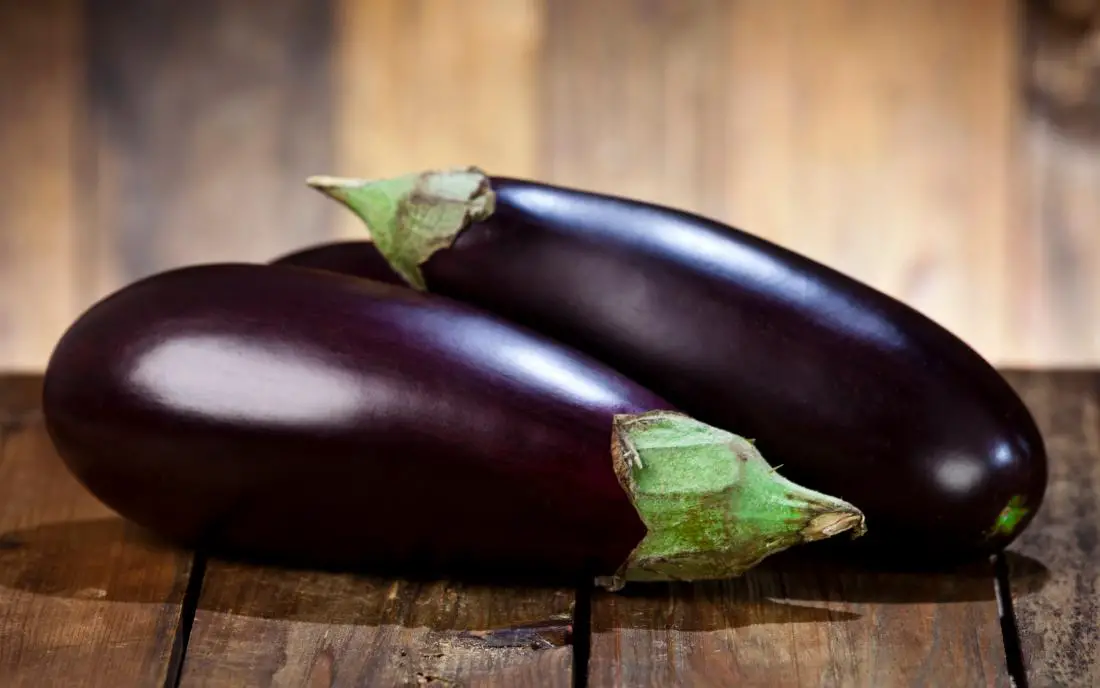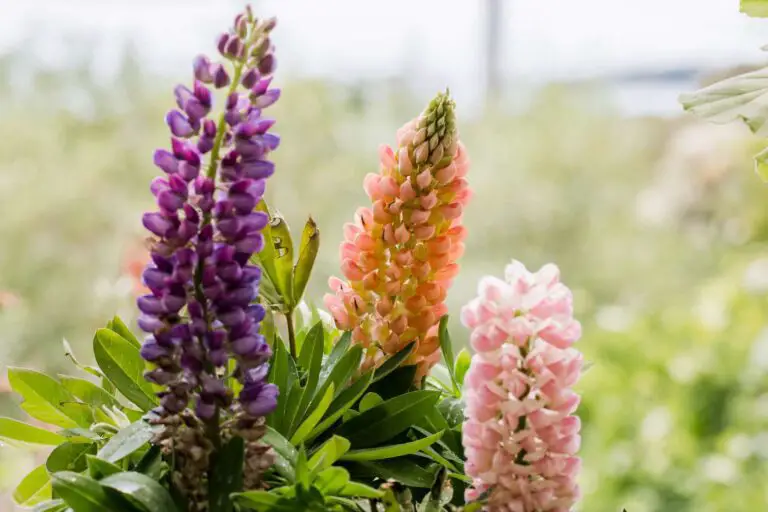Growing Eggplant: Give These Veggies a Try!
Eggplant is a delicious vegetable that is easy to grow in your garden. Did you know that eggplant is actually a type of tomato? As an experienced gardener, I can tell you that eggplant is a great choice for anyone looking to add some flavor to their meals. They’re easy to care for, and their vibrant color makes them a great addition to any dish.
So if you’re looking for a new vegetable to add to your garden, eggplant is a great choice. Get ready to grow these delicious vegetables and add some flavor to your meals!
Table of Contents
Benefits of Growing Eggplant in Your Garden
Eggplants, also known as aubergines, are indeed a versatile and nutritious addition to any garden. Let’s explore the benefits of growing eggplants and how you can enjoy them in your culinary adventures:
:max_bytes(150000):strip_icc()/__opt__aboutcom__coeus__resources__content_migration__mnn__images__2018__06__eggplant-3e0f0e053ba4479d864b97d5c8a2b762.jpg)
- Nutritional Value:
- Eggplants are low in calories but high in fiber, vitamins, and minerals.
- One cup (82 grams) of raw eggplant contains:
- Calories: 20
- Carbs: 5 grams
- Fiber: 3 grams
- Protein: 1 gram
- Vitamins and minerals: Manganese, folate, potassium, vitamin K, and vitamin C.
- Antioxidants: Eggplants are rich in anthocyanins, which protect against cellular damage.
- Heart Health:
- Research suggests that eggplants may help reduce the risk of heart disease.
- They can lower LDL cholesterol and triglycerides, both of which contribute to heart health.
- Eggplants are a heart-healthy addition to your diet.
- Antioxidant Properties:
- Eggplants contain antioxidants that scavenge free radicals and protect cells from damage.
- The skin of eggplants contains a flavonoid called nasunin, which has powerful antioxidant effects.
- Varieties and Culinary Uses:
- Eggplants come in various shapes, sizes, and colors.
- Common varieties include globe (dark purple), Italian (smaller and sweeter), graffiti (slightly sweeter), Chinese (slender and lavender), and Japanese (deeper purple and pungent).
- Use eggplants in dishes like Eggplant Parmesan, ratatouille, or baba ganoush.
- Roast, grill, sauté, or stir-fry eggplants for a burst of flavor and texture in your meals.
So, whether you’re grilling, roasting, or frying them, eggplants offer both health benefits and culinary versatility. Enjoy incorporating these nutrient-rich gems into your cooking! 🍆🌱
Ideal Growing Conditions for Eggplant Plants
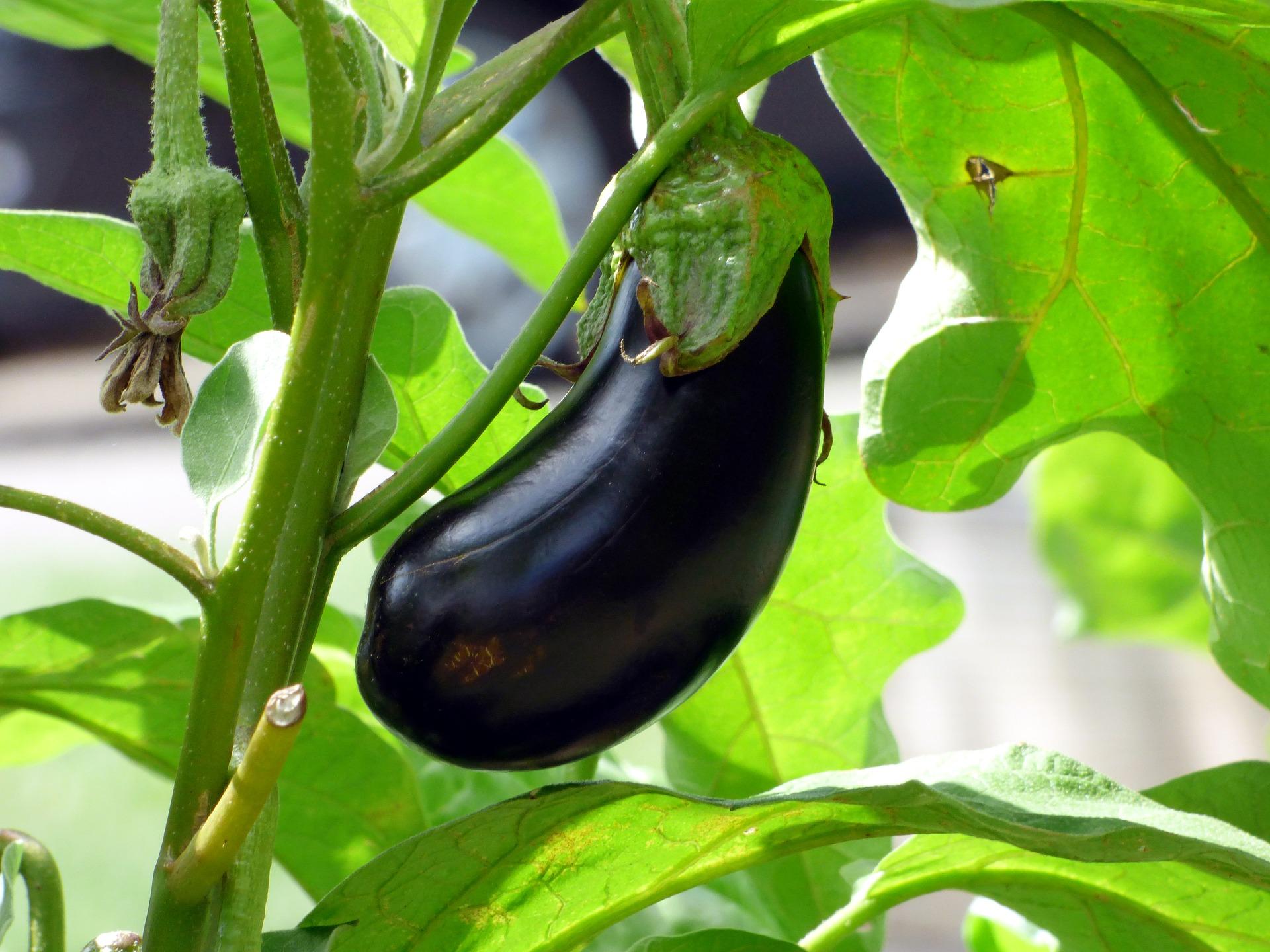
Eggplants, scientifically known as Solanum melongena, are a warm-season vegetable that thrive in specific growing conditions.
- To successfully cultivate eggplant plants, it is crucial to provide them with an environment that mimics their native habitats.
- In addition to the environmental factors, eggplants also require adequate spacing for optimal growth.
- Providing the ideal conditions for eggplant plants not only promotes healthy growth but also increases the chances of a bountiful harvest of this nutritious and versatile vegetable.
The following table explains about the growing conditions for eggplant:
| Growing Condition | Treatment | Effect |
|---|---|---|
| 1. Temperature | – Daytime temperature: 75-85°F (24-29°C) | – Promotes optimal growth and fruiting. |
| – Nighttime temperature: 65-75°F (18-24°C) | – Supports healthy plant metabolism. | |
| 2. Sunlight | – Full sun exposure for 6-8 hours daily. | – Enhances photosynthesis and yields. |
| 3. Soil pH | – pH level: 5.5-6.5 | – Facilitates nutrient uptake. |
| 4. Soil Moisture | – Evenly moist soil, not waterlogged. | – Prevents water stress and wilt. |
| 5. Soil Nutrients | – Balanced fertilization with NPK (10-10-10). | – Supports overall plant health. |
| 6. Spacing | – Plant spacing: 18-24 inches (45-60 cm) | – Allows for proper air circulation. |
Different Types of Eggplant Varieties to Try
Eggplants come in a variety of shapes, sizes, and colors, making them a versatile and exciting addition to any garden. Experimenting with different eggplant varieties can elevate your culinary experiences and bring a touch of novelty to your meals.
| Eggplant Variety | Characteristics | Advantages | Disadvantages |
|---|---|---|---|
| Globe Eggplant (American Eggplant) | – Large, meaty texture – Ideal for slicing and grilling – Suitable for roasting or grilling whole | – Great for grilling recipes – Meaty texture holds up well in cooking | – Can absorb too much oil when frying |
| Italian Eggplant | – Dark purple, teardrop shape – Sweeter flavor than globe eggplant | – Used in Italian recipes (e.g., eggplant Parmesan) – Creamy texture when cooked | – Requires thorough cooking for flavor |
| Japanese Eggplant | – Long and slender – Good for stir-frying – Deep purple color | – Ideal for Szechuan eggplant, Thai grilled eggplant, and pan-fried eggplant with miso | – May be labeled as Japanese even if not from Japan |
| Rosa Bianca Eggplant | – Beautiful purple and white markings – Attractive appearance | – Aesthetically pleasing – Can be used as an ornamental plant | – Color fades when cooked |
| Black Beauty Eggplant | – Classic dark purple color – Commonly found in stores | – Versatile for various recipes | – None reported |
| Listada de Gandia Eggplant | – Purple with white stripes – Unique appearance | – Adds visual interest to dishes | – None reported |
| Fairy Tale Eggplant | – Small and slender – Grilled or roasted as an appetizer | – Perfect for individual servings – Tender skin | – None reported |
Remember to choose eggplants with smooth, shiny skin and a heavy feel for their size. Enjoy experimenting with these different varieties in your cooking! 🍆🌱
How to Start Eggplant Seeds Indoors
To successfully start eggplant seeds indoors, it’s essential to create a conducive environment that mimics the ideal conditions for germination.

Choose high-quality eggplant seeds from a reputable source. Look for varieties that suit your climate and taste preferences.
Use seed trays or small containers filled with a well-draining seed starting mix. Ensure the mix is moist but not waterlogged.
Plant the seeds at a depth of about a quarter to half an inch (6-12 mm) in the seed starting mix.
Cover the seeds lightly with more seed starting mix.
Maintain a consistent temperature of around 70-85°F (21-29°C) for germination.
Mist the soil regularly to keep it consistently damp but not saturated.
Place the seed trays in a bright location with indirect sunlight.
Consider using a grow light if natural sunlight is insufficient.
As the seeds germinate, ensure they receive ample light to promote strong growth.
Keep the seedlings well-hydrated and monitor their growth regularly.
Once the seedlings have developed a couple of sets of true leaves, gently transplant them into individual containers.
Continue caring for the seedlings indoors until they are ready for outdoor planting.
Remember to follow these steps, and soon you’ll have healthy eggplant seedlings ready for your garden! 🍆🌱
Having used these plant growing trays extensively, I must say that I am thoroughly impressed with their quality. The durable plastic construction ensures longevity and reliability, making them a staple in my gardening arsenal. Despite being lightweight, they are remarkably sturdy, capable of withstanding the rigors of regular use without faltering. I particularly appreciate their versatility, as they excel in various applications, from seed starting to microgreen cultivation.Overall, these trays offer exceptional value for money, and I highly recommend them to any gardening enthusiast looking for reliable and durable plant growing trays.
- Sturdy Construction: The plant growing trays are made of durable plastic, providing reliable support for seedlings and microgreens.
- Versatile Use: Suitable for various gardening applications, including seed starting, indoor gardening, and growing microgreens, offering flexibility for different plant needs.
- Perfect Size: With dimensions of 20″ x 10″, the trays are spacious enough to accommodate multiple seedlings while remaining compact for easy handling.
- Reusable: These trays can be reused multiple times, making them a cost-effective and sustainable option for gardeners.
- Compatible Design: The precise fit for Sure to Grow pads and Micro-Mats hydroponic pads ensures compatibility with different growing methods.
- Lack of Drain Holes: Some users may find the absence of drain holes inconvenient, as it requires careful watering to prevent waterlogging and potential root rot.
- Limited Durability: While sturdy, the trays may weaken over time, especially after multiple uses, which could affect their longevity and performance.
- Sheerness: A few customers have noted concerns about the trays’ sheerness, suggesting they may not withstand heavy loads or rough handling as effectively.
Transplanting Eggplant Seedlings into the Garden
When transplanting eggplant seedlings into your garden, follow these steps for a successful transition:
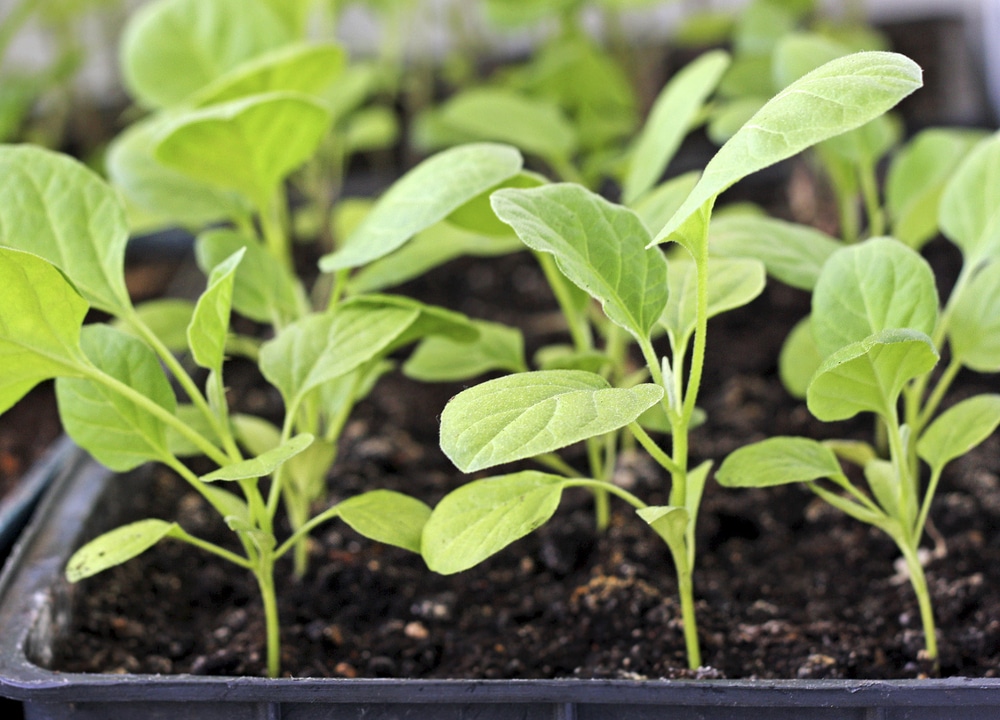
- Choose the Right Spot:
- Select a sunny location with well-draining soil. Eggplants thrive in warm temperatures, ideally between 70-85°F during the day and above 60°F at night.
- Ensure the soil is rich in organic matter and has a pH level of around 6.0-6.8.
- Prepare the Seedlings:
- Carefully remove the seedlings from their containers.
- Gently loosen the roots to encourage healthy growth.
- Planting:
- Dig a hole as large as the pot your seedling is currently housed in.
- Keep plants about 18-24 inches apart to allow for proper growth and airflow.
- Plant the seedlings into the soil and cover with soil gently.
- Place a stake near them right away to provide support as they grow.
- Watering and Mulching:
- Water the seedlings thoroughly after transplanting to help them establish in their new environment.
- Avoid over-watering, as eggplants are susceptible to root rot.
- Mulch around the plants to retain moisture and suppress weeds.
- Fertilization and Support:
- Consider using a balanced fertilizer to encourage healthy growth and fruit development.
- Monitor the plants regularly for signs of stress or pests.
- Provide support such as stakes or cages as the eggplants mature to prevent them from bending or breaking.
Remember that eggplants are sensitive to cold temperatures, so ensure there is no danger of frost before transplanting. With proper care, you’ll soon enjoy homegrown eggplants in your garden! 🍆🌱
Proper Watering Techniques for Eggplant Plants
Here are the key points for proper eggplant watering techniques:

- Frequency: Water deeply once or twice a week.
- Soil Moisture: Keep the soil evenly moist but not waterlogged.
- Mulching: Use mulch around the base of plants to retain moisture.
- Base Watering: Direct water at the base, avoiding wetting the foliage.
- Morning Watering: Water early in the morning to allow evaporation.
Remember these tips, and your eggplants will thrive! 🌱🍆
Fertilizing Eggplant Plants for Healthy Growth
To ensure robust growth and bountiful harvests, proper fertilization is crucial for eggplant plants. When it comes to fertilizing eggplants, it is essential to provide a balanced nutrient mix that includes nitrogen, phosphorus, and potassium. These macronutrients play a vital role in promoting healthy plant growth, strong root development, and ample fruit production.
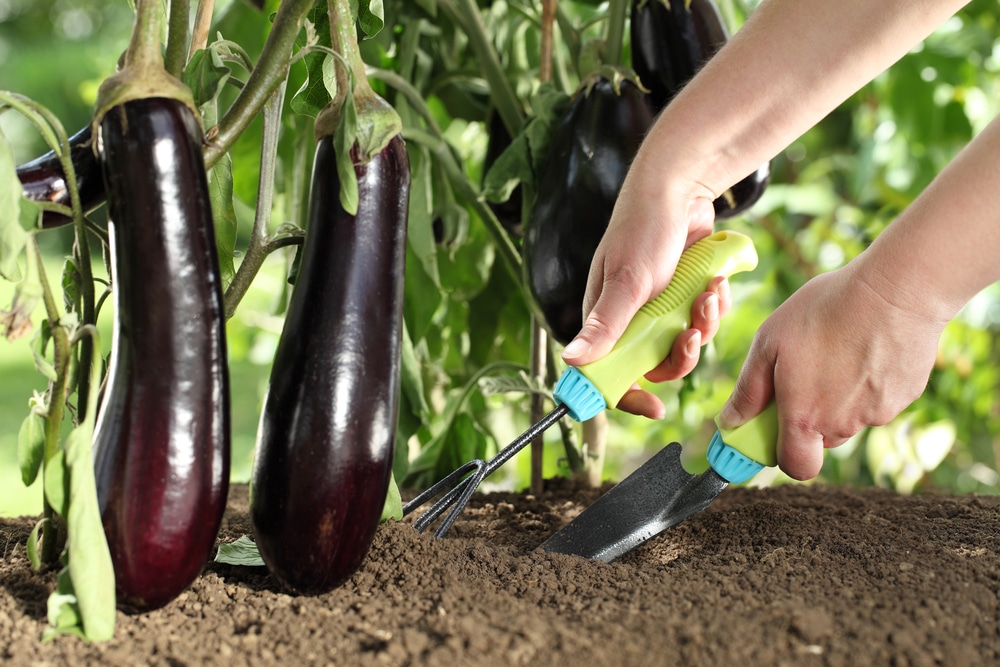
- Nitrogen (N):
- Role: Nitrogen is essential for lush foliage growth and overall plant vigor.
- Application:
- Incorporate nitrogen-rich organic fertilizers into the soil before planting.
- Use compost or well-rotted manure to provide a slow-release source of nitrogen.
- Avoid excessive nitrogen, as it can lead to excessive leafy growth at the expense of fruit production.
- Phosphorus (P):
- Role: Phosphorus is vital for flower and fruit formation.
- Application:
- Mix a phosphorus-rich fertilizer into the soil during planting.
- Look for a balanced NPK (nitrogen-phosphorus-potassium) ratio, with higher phosphorus content.
- Phosphorus availability decreases in alkaline soils, so consider adjusting pH if needed.
- Potassium (K):
- Role: Potassium contributes to disease resistance, stress tolerance, and overall plant health.
- Application:
- Use a potassium-rich fertilizer during planting or as a top dressing.
- Potassium sulfate or potassium chloride are common sources.
- Adequate potassium levels enhance fruit quality and yield.
- Application Tips:
- Slow-Release Fertilizers: Consider using slow-release organic fertilizers. These gradually release nutrients over time.
- Liquid Fertilizers: Apply liquid fertilizers during the growing season. Dilute them according to the manufacturer’s instructions.
- Timing: Follow recommended application rates and timing to prevent overfertilization.
Remember, healthy eggplants result from a balanced nutrient supply. Regular monitoring and adjustments based on plant needs will help you achieve optimal results in your garden! 🍆🌱
The following table explains about the fertilizing eggplant:
| Fertilizer Treatment | Nutrient Composition | Application Rate | Effect on Growth |
|---|---|---|---|
| 1. Nitrogen (N) | 20-20-20 NPK fertilizer | 1 tablespoon per plant | Promotes leafy growth |
| 2. Phosphorus (P) | 10-20-10 NPK fertilizer | 1 tablespoon per plant | Enhances root development |
| 3. Potassium (K) | 15-15-15 NPK fertilizer | 1 tablespoon per plant | Improves fruiting and yield |
| 4. Calcium (Ca) | Calcium nitrate (15.5-0-0) | 1 teaspoon per plant | Prevents blossom end rot |
| 5. Magnesium (Mg) | Epsom salt (magnesium sulfate) | 1 tablespoon per plant | Aids in chlorophyll production |
Note: These quantitative values represent recommended application rates for fertilizing eggplant plants at different growth stages. Each fertilizer treatment targets specific nutrients essential for healthy growth, resulting in improved plant vigor and yield.
I recently purchased the AgroThrive All Purpose Organic Liquid Fertilizer, and I must say, I am thoroughly impressed. What sets this product apart is its exceptional quality. Unlike other fertilizers I’ve used in the past, AgroThrive delivers on its promise of being organic and natural, which gives me peace of mind knowing that it’s safe for my plants, soil, and the environment. The fast-acting formula, thanks to the Progressive Digestion Process, ensures that my plants receive the essential nutrients they need in a matter of days, resulting in visibly healthier growth.
Additionally, its versatility makes it suitable for various applications, from home gardens to farms, indoors to outdoors. Overall, the outstanding quality of AgroThrive All Purpose Organic Liquid Fertilizer has exceeded my expectations, making it a staple in my gardening routine.
- Organic and natural: Formulated from organic fish and grain, ensuring safety for plants, soil, and the environment.
- Fast-acting: Utilizes the Progressive Digestion Process to break down nutrients for rapid absorption by plants, providing quick results in less than a week.
- Versatile: Suitable for use in home gardens, farms, hydroponics, greenhouses, indoors, and outdoors.
- Improves soil health: Activates indigenous micro-flora in the soil, aiding nutrient release and enhancing overall soil fertility.
- Easy to use: Clear instructions provided for measuring, diluting, and applying the fertilizer, making it user-friendly.
- Strong odor: Some users find the smell unpleasant, which may linger after application, particularly problematic for those with sensitive noses or in close proximity to neighbors.
- Mixed feedback on effectiveness: While many users praise its efficacy, some customers have reported mixed results, particularly in hydroponic setups.
- Limited availability: Not readily available in stores like Home Depot or Lowes, requiring online ordering, which may inconvenience some users.
Common Pests and Diseases that Affect Eggplants
The health and productivity of eggplant plants can be significantly affected by various common pests and diseases.
| Pest/Disease | Symptoms | Treatment | Effect on Plant |
|---|---|---|---|
| Aphids | – Curling leaves- Sticky honeydew- Stunted growth- Distorted shoots | – Spray with insecticidal soap or neem oil- Introduce ladybugs or lacewings- Remove affected leaves | – Reduced vigor- Poor fruit development |
| Flea Beetles | – Tiny holes in leaves- Shiny, black beetles jumping when disturbed | – Use row covers to prevent infestation- Apply diatomaceous earth or insecticidal spray | – Defoliation- Reduced yield |
| Whiteflies | – Yellowing leaves- Sticky residue on leaves- Sooty mold growth | – Use yellow sticky traps- Apply neem oil or insecticidal soap- Encourage natural predators | – Weakened plants- Reduced photosynthesis |
| Spider Mites | – Fine webbing on leaves- Yellow stippling- Leaf drop | – Spray with water to dislodge mites- Apply insecticidal soap or neem oil | – Reduced plant vitality- Poor fruit quality |
| Verticillium Wilt | – Yellowing and wilting of leaves- Browning of vascular tissue | – No cure; remove infected plants promptly- Rotate crops to prevent spread | – Wilting and decline- Reduced yield |
| Bacterial Wilt | – Sudden wilting during hot days- Yellowing of leaves | – No cure; remove infected plants- Avoid overhead watering | – Rapid plant collapse- Death |
| Powdery Mildew | – White powdery spots on leaves- Distorted growth | – Improve air circulation- Apply fungicidal spray | – Reduced photosynthesis- Aesthetic damage |
| Early Blight | – Brown spots with concentric rings on leaves- Leaf yellowing | – Remove affected leaves- Apply copper-based fungicides | – Reduced foliage- Lower yield |
| Late Blight | – Dark, water-soaked lesions on leaves- White fungal growth | – Remove infected leaves and destroy- Apply copper-based fungicides | – Rapid defoliation- Fruit rot |
| Root Knot Nematodes | – Stunted growth- Yellowing leaves- Root galls | – Plant resistant varieties- Solarize soil- Rotate crops | – Reduced root function- Poor nutrient uptake |
Remember to monitor your eggplants regularly and take preventive measures to keep them healthy. 🍆🌱
Tips for Pruning Eggplant Plants
Pruning eggplant plants is essential for maximizing their yield and promoting healthy growth.

- Start by removing any damaged or diseased leaves as soon as you see them to prevent the spread of infections.
- Additionally, trimming off any yellow or discolored leaves can help redirect the plant’s energy towards developing new, vibrant foliage and fruit.
- When pruning your eggplant, focus on removing any suckers that develop in the leaf axils.
- These small side shoots can divert nutrients away from the main stem and fruit-bearing branches, impacting the overall productivity of the plant.
- By regularly pruning these suckers, you can encourage stronger stems and better fruit development.
Harvesting Eggplant at the Right Time
Harvesting eggplant at the right time is crucial to ensure the best flavor and texture in your dishes.

- Size and Appearance:
- Harvest eggplants when they are young and shiny, typically around 5 to 6 inches in length.
- Avoid letting the eggplant become dull or develop a tough skin, as this can lead to a bitter taste.
- Readiness Test:
- Gently press the skin of the eggplant with your thumb.
- If it leaves an indent that bounces back, the eggplant is ripe and ready for harvest.
- Harvesting Technique:
- Use a sharp knife or pruning shears to cut the fruit from the plant.
- Leave a small portion of the stem attached to prevent damage to the plant.
- Handle the eggplant carefully to avoid bruising.
- Regular Harvesting:
- Regularly check your eggplants for readiness.
- Harvest ripe eggplants promptly to encourage the plant to keep producing more fruit throughout the growing season.
Enjoy your homegrown eggplants! 🍆🌱
Creative Recipes to Try Using Eggplant
Eggplants are incredibly versatile vegetables that can be used in a myriad of delicious recipes.

- Eggplant Parmesan (Melanzane alla Parmigiana):
- Description: Layers of thinly sliced eggplant are breaded, fried, and then assembled with marinara sauce and cheese (usually mozzarella and Parmesan). Baked until bubbly and golden.
- Serving: Serve it as a hearty main course with a side of pasta or crusty bread.
- Baba Ganoush:
- Description: A classic Middle Eastern dip made from roasted eggplant, tahini, garlic, lemon juice, and olive oil. Creamy, smoky, and full of flavor.
- Serving: Enjoy it with pita bread, fresh veggies, or as a spread in sandwiches.
- Grilled Eggplant and Mozzarella Sandwiches:
- Description: Grilled eggplant slices are layered with fresh mozzarella, ripe tomatoes, basil leaves, and a drizzle of balsamic glaze. All sandwiched between slices of crusty bread.
- Serving: Perfect for a light lunch or dinner.
- Eggplant Stir-Fry:
- Description: Sautéed eggplant with colorful bell peppers, onions, garlic, and ginger. Season with soy sauce, sesame oil, and a touch of honey.
- Serving: Serve over steamed rice or noodles.
- Eggplant Curry:
- Description: Eggplant chunks simmered in a fragrant curry sauce made with spices like cumin, coriander, turmeric, and garam masala.
- Serving: Pair it with naan or rice for a comforting meal.
- Eggplant Lasagna:
- Description: Replace traditional lasagna noodles with thinly sliced eggplant layers. Alternate with ricotta cheese, marinara sauce, and mozzarella.
- Serving: A delightful twist on the classic Italian dish.
- Eggplant Rollatini:
- Description: Roll up roasted eggplant slices with a ricotta and spinach filling. Top with marinara sauce and bake until bubbly.
- Serving: Elegant and satisfying.
- Stuffed Eggplant Boats:
- Description: Cut eggplants in half lengthwise, scoop out the flesh, and fill with a mixture of cooked grains (like quinoa or couscous), vegetables, herbs, and feta cheese.
- Serving: A wholesome and visually appealing dish.
Remember to explore and experiment with different flavors and cuisines to find your favorite way to enjoy eggplants! Bon appétit! 🍆🌟
Recipe: Eggplant Parmesan
Ingredients:
- 2 medium eggplants, sliced into 1/4-inch rounds
- 2 cups breadcrumbs
- 1 cup grated Parmesan cheese
- 2 eggs, beaten
- 2 cups marinara sauce
- 2 cups shredded mozzarella cheese
- Salt and pepper to taste
- Olive oil for frying
Instructions:
Prep the Eggplant:
- Sprinkle salt over the eggplant slices and let them sit for about 30 minutes to draw out excess moisture. Pat dry with paper towels.
Breading the Eggplant:
- In one bowl, mix breadcrumbs with grated Parmesan cheese. In another bowl, beat the eggs.
- Dip each eggplant slice into the beaten eggs, then coat with the breadcrumb mixture.
Frying the Eggplant:
- Heat olive oil in a large skillet over medium heat. Fry the breaded eggplant slices until golden brown on both sides. Place them on a paper towel-lined plate to drain excess oil.
Assembling the Dish:
- Preheat the oven to 375°F (190°C). Spread a thin layer of marinara sauce on the bottom of a baking dish.
- Arrange a layer of fried eggplant slices on top of the sauce. Add a layer of marinara sauce and sprinkle with mozzarella cheese. Repeat the layers.
Baking:
- Cover the baking dish with foil and bake for about 30 minutes. Remove the foil and bake for an additional 10-15 minutes until the cheese is bubbly and golden.
Serve:
- Let it cool slightly before serving. Garnish with fresh basil or parsley if desired.
This classic Eggplant Parmesan recipe is a delicious way to enjoy eggplant, with its crispy texture, savory flavors, and gooey melted cheese. It’s a comforting dish that can be served as a main course alongside a fresh salad or crusty bread. Enjoy!
Storing Eggplant for Extended Freshness
After harvesting your fresh eggplants from the garden, proper storage is key to maintaining their quality and flavor for an extended period.
:max_bytes(150000):strip_icc()/101975612_preview-1-66604c17fbfb4062b9013c6b088c3f77.jpg)
- Refrigeration for Short-Term Storage:
- Wash and dry eggplants thoroughly before storing.
- Place them in a perforated plastic bag or container in the refrigerator’s crisper drawer.
- Use fresh eggplants within 5 to 7 days for optimal taste and texture.
- Freezing for Long-Term Storage:
- Slice or cube eggplants, blanch in boiling water, then plunge into ice water to stop cooking.
- Drain well, pack in airtight containers or freezer bags, and store in the freezer.
- Frozen eggplants can be stored for up to 8 to 10 months.
- Pickling for Preservation:
- Experiment with pickling recipes to preserve eggplants’ freshness and flavor.
- Enjoy home-pickled eggplants as a tasty addition to various dishes throughout the year.
Preserving Eggplant through Pickling or Freezing
Preserving eggplant through pickling or freezing is a wonderful way to enjoy the delightful flavor of this versatile vegetable all year round. Let’s explore both methods:
- Pickling Eggplants:
- Process: Slice the eggplants thinly and pack them into sterilized jars.
- Ingredients: Add vinegar (such as white wine vinegar or apple cider vinegar), herbs (like garlic, dill, or thyme), and spices (such as black peppercorns or red pepper flakes).
- Flavor Infusion: Let the flavors meld together over time. The tangy twist from the vinegar enhances the eggplant’s taste.
- Usage: Enjoy pickled eggplants on their own as a condiment or add them to salads, sandwiches, or charcuterie boards.
- Freezing Eggplants:
- Blanching: Briefly blanch eggplant slices or cubes in boiling water. This helps retain their texture and color.
- Packaging: Allow the blanched eggplants to cool, then pack them into airtight freezer bags or containers.
- Usage: Use frozen eggplants in stews, curries, casseroles, or dips. They’ll maintain their taste and nutritional value.
- Tip: Label the containers with the date to keep track of freshness.
Remember, whether you pickle or freeze, you’ll be able to enjoy the fresh taste of summer even during the colder months. Happy preserving! 🌱🍆
Health Benefits of Eating Eggplant Regularly
Eggplants are indeed a delightful addition to both our plates and our health. Let’s explore their benefits in more detail:
- Low in Calories, High in Fiber:
- Caloric Content: Eggplants are low in calories, making them a guilt-free choice for those watching their weight.
- Fiber: Their high fiber content supports digestive health by promoting regular bowel movements and preventing constipation.
- Antioxidant-Rich Purple Skin:
- Anthocyanins: The rich purple skin of eggplants contains anthocyanins, powerful antioxidants.
- Health Benefits:
- Reduced Inflammation: Anthocyanins have anti-inflammatory properties.
- Heart Health: They may improve heart health by reducing oxidative stress and enhancing blood vessel function.
- Vitamins and Minerals:
- Vitamin K: Essential for blood clotting and bone health.
- Vitamin C: Boosts immunity and supports skin health.
- Potassium: Important for maintaining healthy blood pressure.
- Folate: Vital for cell division and growth.
- Nasunin: A Protective Antioxidant:
- Nasunin: Found in eggplant skin, nasunin is a potent antioxidant.
- Cell Protection: It helps protect cells from damage caused by free radicals.
- Reduced Disease Risk: Some studies suggest it may reduce the risk of chronic diseases.
- Cholesterol Management and Weight Control:
- Cholesterol: Eggplants may help improve blood cholesterol levels.
- Weight Management: Their low-calorie content and fiber contribute to satiety, aiding weight management.
- Gut Health:
- High Fiber: Eggplants’ fiber supports gut health by promoting beneficial gut bacteria.
- Regular Bowel Movements: Fiber prevents constipation and maintains digestive regularity.
Incorporating eggplants into your meals not only adds flavor but also contributes to your overall well-being. Bon appétit! 🍆🌱
Exploring Cultural Significance of Eggplant in Different Cuisines
Eggplant, a versatile vegetable loved for its meaty texture and ability to absorb flavors, holds a significant place in various cuisines around the world.

- Versatility Across Cultures:
- Eggplant is beloved worldwide for its meaty texture and flavor-absorbing qualities.
- Found in dishes like baba ghanoush, Baingan Bharta, Eggplant Parmesan, Nasu Dengaku, and Imam Bayildi.
- Used in Middle Eastern, Indian, Italian, Japanese, and Turkish cuisines, showcasing its adaptability to various cooking styles and flavor profiles.
- Middle Eastern and Indian Delicacies:
- Creamy baba ghanoush and spicy Baingan Bharta highlight eggplant’s versatility in Middle Eastern and Indian cuisines.
- Italian Classics:
- Eggplant Parmesan, or Melanzane Alla Parmigiana, is a hearty and delicious dish in Italian cuisine.
- Japanese Delights:
- Nasu Dengaku features miso-glazed eggplant grilled to perfection, showcasing eggplant’s ability to absorb complex umami flavors.
- Turkish Traditions:
- Imam Bayildi, meaning “the imam fainted,” is a Turkish dish known for its rich flavors and cultural significance.
- Global Culinary Superstar:
- Eggplant’s role in diverse cultural settings proves its status as a global culinary favorite.
Final Thoughts on Growing Eggplant Successfully
Patience and Consistency:
- Reflect on the journey of growing eggplants in your garden, emphasizing patience and consistency throughout.
- Each step, from seed starting to fruit harvesting, requires attention and care.
Optimal Growing Conditions:
- Provide optimal growing conditions and proper maintenance to ensure a successful eggplant harvest.
- Vigilance against pests and diseases is crucial for healthy plants.
Joy of Gardening:
- Growing eggplants is not just about the end result but also the joy and satisfaction derived from nurturing plants from seed to fruit.
- Embrace challenges, learn from experiences, and experiment with different varieties and techniques.
Beyond Bountiful Harvests:
- Growing your own eggplants offers rewards beyond the delicious dishes, providing a sense of accomplishment and connection to the natural world.
Watch video for more information:
FAQ
Can I grow eggplant in a container instead of a garden?
Yes, eggplants can be grown in containers as long as they have enough room to grow and receive adequate sunlight.
How often should I water my eggplant plants?
Eggplant plants require consistent watering to keep the soil evenly moist, typically around 1-2 inches of water per week.
Are there any natural ways to prevent pests from damaging my eggplant plants?
Yes, you can try planting companion plants like marigolds or basil to help deter pests, or use organic insecticidal soap to control common pests.
What is the best way to store harvested eggplants?
Store harvested eggplants in a cool, dry place or in the refrigerator for up to a week. Avoid washing them until you are ready to use them.
How can I preserve excess eggplants for later use?
You can pickle eggplants by slicing them and soaking them in a vinegar mixture, or freeze them after blanching for future use in recipes.
What are some health benefits of eating eggplant regularly?
Eggplants are low in calories, high in fiber, and contain antioxidants that can help improve heart health, aid in digestion, and reduce inflammation in the body.

Studied Agricultural Engineering-Plant Protection at University of California, Davis.
Head of Content writing team at Southelmontehydroponics.com

